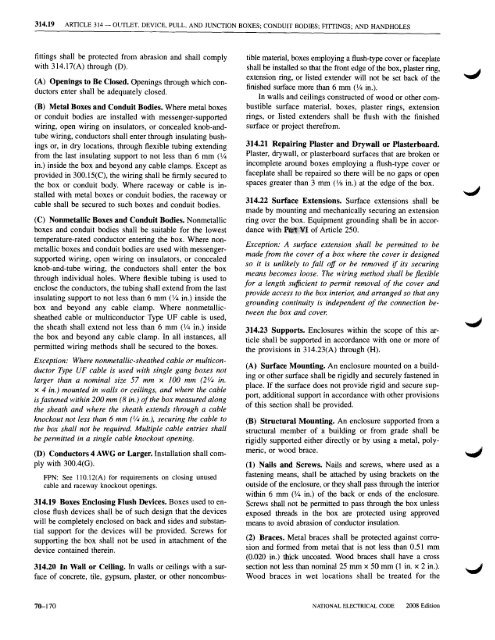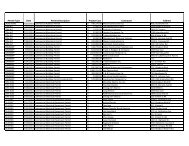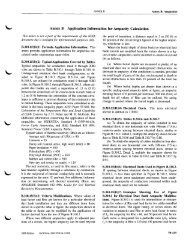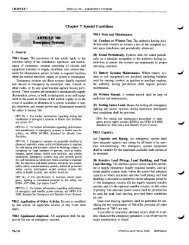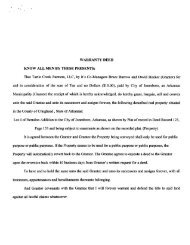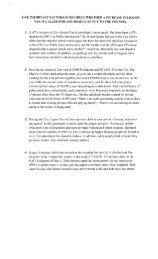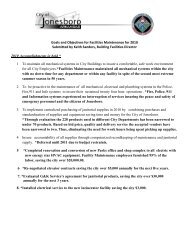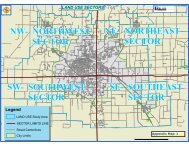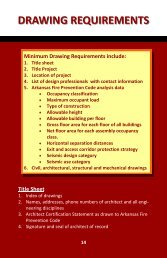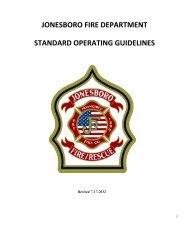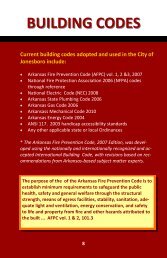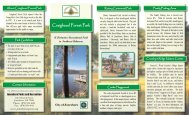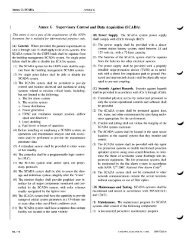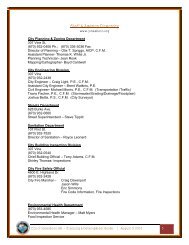Chapter 3 Wiring Methods and Materials
Chapter 3 Wiring Methods and Materials
Chapter 3 Wiring Methods and Materials
You also want an ePaper? Increase the reach of your titles
YUMPU automatically turns print PDFs into web optimized ePapers that Google loves.
314.19 ARTICLE 314- OUTLET. DEVICE, PULL, AND JUNCTION BOXES; CONDUIT BODIES; FITTINGS; AND HANDHOLES<br />
fittings shall be protected from abrasion <strong>and</strong> shall comply<br />
with 314.l7(A) through (D).<br />
(A) Openings to Be Closed. Openings through which conductors<br />
enter shall be adequately closed.<br />
(B) Metal Boxes <strong>and</strong> Conduit Bodies. Where metal boxes<br />
or conduit bodies are installed with messenger-supported<br />
wiring, open wiring on insulators, or concealed knob-<strong>and</strong>tube<br />
wiring, conductors shall enter through insulating bushings<br />
or, in dry locations, through flexible tubing extending<br />
from the last insulating support to not less than 6 mm (1,4<br />
in.) inside the box <strong>and</strong> beyond any cable clamps. Except as<br />
provided in 300.l5(C), the wiring shall be finnly secured to<br />
the box or conduit body. Where raceway or cable is installed<br />
with metal boxes or conduit bodies, the raceway or<br />
cable shall be secured to such boxes <strong>and</strong> conduit bodies.<br />
(C) Nonmetallic Boxes <strong>and</strong> Conduit Bodies. Nonmetallic<br />
boxes <strong>and</strong> conduit bodies shall be suitable for the lowest<br />
temperature-rated conductor entering the box. Where nonmetallic<br />
boxes <strong>and</strong> conduit bodies are used with messengersupported<br />
wiring, open wiring on insulators, or concealed<br />
knob-<strong>and</strong>-tube wiring, the conductors shall enter the box<br />
through individual holes. Where flexible tubing is used to<br />
enclose the conductors, the tubing shall extend from the last<br />
insulating support to not less than 6 mm (1/4 in.) inside the<br />
box <strong>and</strong> beyond any cable clamp. Where nonmetallicsheathed<br />
cable or multiconductor Type UF cable is used,<br />
the sheath shall extend not less than 6 mm (V4 in.) inside<br />
the box <strong>and</strong> beyond any cable clamp. In all instances, all<br />
pennitted wiring methods shall be secured to the boxes.<br />
Exception: Where nonmetallic-sheathed cable or multiconductor<br />
Type UF cable is used with single gang boxes not<br />
larger than a nominal size 57 mm x 100 mm (2//4 in.<br />
x 4 in.) mounted in walls or ceilings, <strong>and</strong> where the cable<br />
isfastened within 200 mm (8 in.) ofthe box measured along<br />
the sheath <strong>and</strong> where the sheath extends through a cable<br />
knockout not less than 6 mm (//4 in.), securing the cable to<br />
the box shall not be required. Multiple cable entries shall<br />
be pennitted in a single cable knockout opening.<br />
(D) Conductors 4 AWG or Larger. Installation shall comply<br />
with 300A(G).<br />
FPN: See 1l0.12(A) for requirements on closing unused<br />
cable <strong>and</strong> raceway knockout openings.<br />
314.19 Boxes Enclosing Flush Devices. Boxes used to enclose<br />
flush devices shall be of such design that the devices<br />
will be completely enclosed on back <strong>and</strong> sides <strong>and</strong> substantial<br />
support for the devices will be provided. Screws for<br />
supporting the box shall not be used in attachment of the<br />
device contained therein.<br />
314.20 In Wall or Ceiling. In walls or ceilings with a surface<br />
of concrete, tile, gypsum, plaster, or other noncombustible<br />
material, boxes employing a flush-type cover or faceplate<br />
shall be installed so that the front edge of the box, plaster ring,<br />
extension ring, or listed extender will not be set back of the<br />
finished surface more than 6 rom (~ in.).<br />
In walls <strong>and</strong> ceilings constructed of wood or other combustible<br />
surface material, boxes, plaster rings, extension<br />
rings, or listed extenders shall be flush with the finished<br />
surface or project therefrom.<br />
314.21 Repairing Plaster <strong>and</strong> Drywall or Plasterboard.<br />
Plaster, drywall, or plasterboard surfaces that are broken or<br />
incomplete around boxes employing a flush-type cover or<br />
faceplate shall be repaired so there will be no gaps or open<br />
spaces greater than 3 mm (V8 in.) at the edge of the box.<br />
314.22 Surface Extensions. Surface extensions shall be<br />
made by mounting <strong>and</strong> mechanically securing an extension<br />
ring over the box. Equipment grounding shall be in accordance<br />
with of Article 250.<br />
Exception: A surface extension shall be permitted to be<br />
made from the cover of a box where the cover is designed<br />
so it is unlikely to fall off or be removed if its securing<br />
means becomes loose. The wiring method shall be flexible<br />
for a length sufficient to permit removal of the cover <strong>and</strong><br />
provide access to the box interior, <strong>and</strong> arranged so that any<br />
grounding continuity is independent of the connection between<br />
the box <strong>and</strong> cover.<br />
314.23 Supports. Enclosures within the scope of this article<br />
shall be supported in accordance with one or more of<br />
the provisions in 314.23(A) through (H).<br />
(A) Surface Mounting. An enclosure mounted on a building<br />
or other surface shall be rigidly <strong>and</strong> securely fastened in<br />
place. If the surface does not provide rigid <strong>and</strong> secure support,<br />
additional support in accordance with other provisions<br />
of this section shall be provided.<br />
(B) Structural Mounting. An enclosure supported from a<br />
structural member of a building or from grade shall be<br />
rigidly supported either directly or by using a metal, polymeric,<br />
or wood brace.<br />
(1) Nails <strong>and</strong> Screws. Nails <strong>and</strong> screws, where used as a<br />
fastening means, shall be attached by using brackets on the<br />
outside of the enclosure, or they shall pass through the interior<br />
within 6 rom (V4 in.) of the back or ends of the enclosure.<br />
Screws shall not be permitted to pass through the box unless<br />
exposed threads in the box are protected using approved<br />
means to avoid abrasion of conductor insulation.<br />
(2) Braces. Metal braces shall be protected against corrosion<br />
<strong>and</strong> fonned from metal that is not less than 0.51 mm<br />
(0.020 in.) thick uncoated. Wood braces shall have a cross<br />
section not less than nominal 25 mm x 50 mm (1 in. x 2 in.).<br />
Wood braces in wet locations shall be treated for the<br />
70-170<br />
NATIONAL ELECTRICAL CODE<br />
2008 Edition


